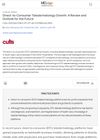Accessibility of Direct-to-Consumer Teledermatology to Underserved Populations
March 2022
in “
Journal of The American Academy of Dermatology
”
teledermatology direct-to-consumer teledermatology DTC teledermatology photography diagnostic modality commercial insurance Medicaid Hispanic/Latino community language barriers digital literacy insurance acceptance photo diagnosis insurance Hispanic community language issues tech literacy insurance coverage

TLDR Direct-to-consumer teledermatology is not effectively reaching underserved populations due to language, technology, and insurance barriers.
The document discusses the accessibility of direct-to-consumer (DTC) teledermatology platforms to underserved populations. The study examined 14 DTC websites and found that only 4 (28%) provided a non-English language interface, with Spanish available on 2 platforms and no Asian languages offered. All sites required email registration and used photography as the primary diagnostic modality. Only 6 (43%) services accepted commercial insurance and 2 (14%) also accepted Medicaid. The study also highlighted that the Hispanic/Latino community, one of the largest medically underserved populations in the U.S., faces barriers to access due to limited English proficiency and technological demands. The study concluded that despite marketing a more egalitarian approach, DTC teledermatology, as currently structured, does not appear to mitigate well-known barriers to access such as language, digital literacy, and insurance acceptance.



